Fiji Customs allow yachts to stay in the country for 18 months, but Immigration only allow visitors 4 months. Our visas were going to expire in 3 1/2 weeks so we had to leave the country or apply for a visa extension. We were told it was a fairly simple process but could take some time. We researched how to get from Nananu-I-Cake to the nearest immigration office. Though not the cheapest, it seemed quickest and easiest to leave the boat and take a taxi to Lautoka. We could combine it with a provisioning trip.
Our taxi driver, Abhinash (“Avi”), had driven us to Rakiraki for a few provisioning runs. Due to the speed limit, numerous speed bumps and traffic, it took a couple hours to drive the 115km road to Lautoka. He asked if we wanted to do a bit of sightseeing on the way. Always keen to learn more about the country and get a few photo ops from land, we agreed. He shared some facts and history and pointed out interesting spots along the route.
Our first stop was a few kilometres passed Rakiraki. The significance of this site was the grave of Chief Ratu Udreudre, the Guinness World Record holder for “the most prolific cannibal”. He reportedly consumed every piece of his 872 to 999 victims, sharing none. It is said he ate little else and had an enormous appetite. A stone was placed by his grave to mark each victim, but it was too overgrown to see them.
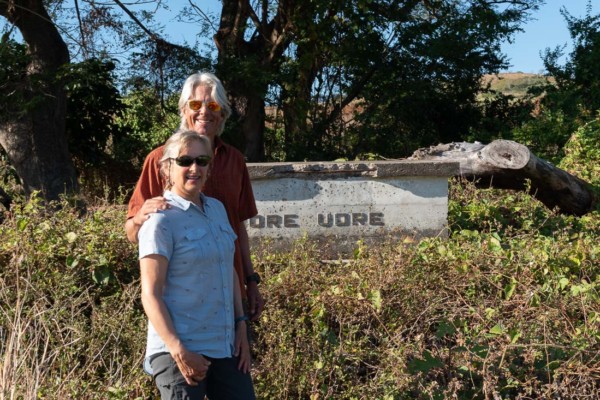
An odd backdrop for a photo of us!
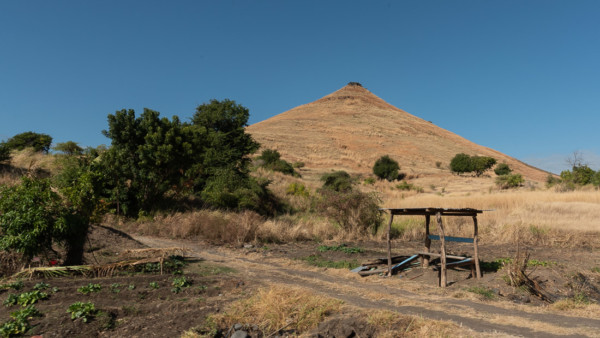
Just like a pyramid!
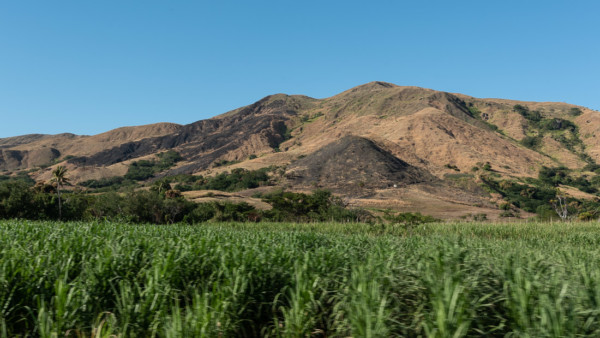
Typical scene at this time of year, cane fields with grass burned up the hillside.
There are two reasons for burning in Fiji. One is to make the cane easier to cut as the green leaves are very sharp. The downside is that the yield is lower when the cane is burned and it has to be processed very soon after. The other reason for fires is to burn off to the old dead grass so that new grass will sprout up when the rains come, providing better grazing land for the animals. That made sense to me, being a farm girl. Dad used to do the same on our Gaston Road farm. I recall the family helping to douse the flames with wet gunny sacks.
Just a short detour off the main road, was the Fiji Water bottling plant. Established by Canadian David Gilmour in 1996, it was sold to an American investment group in 2004 for a massive profit. It is Fiji’s most recognized global brand. The water is sourced from a natural artesian well fed by the Nakauvadra Range, home to Degei, the most powerful Fijian god. Visitor tours are not conducted.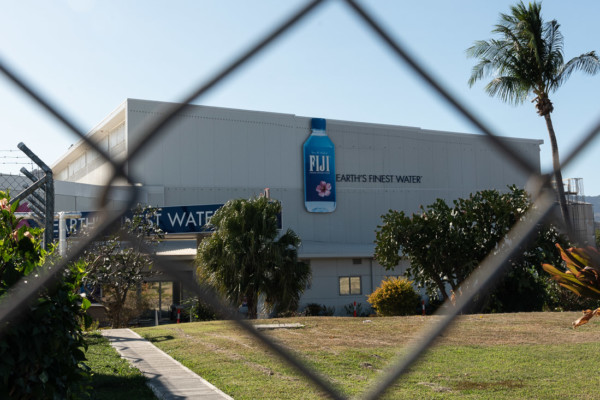
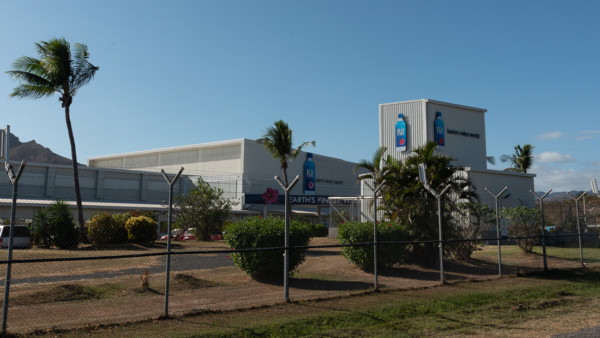
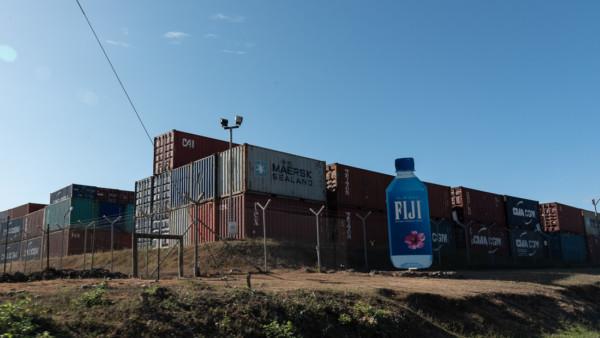
The company started out small but now ships containers all over the world.

Cattle country
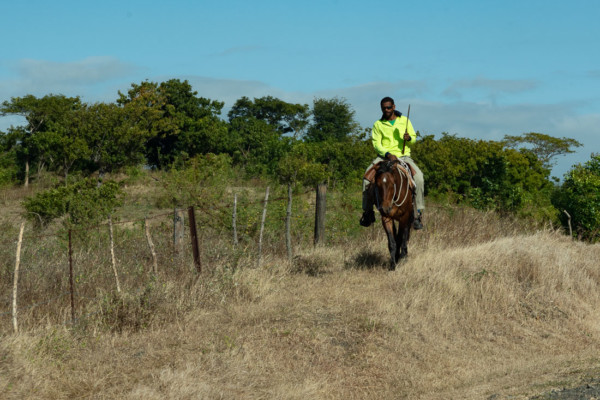
Cowboy, Fiji style
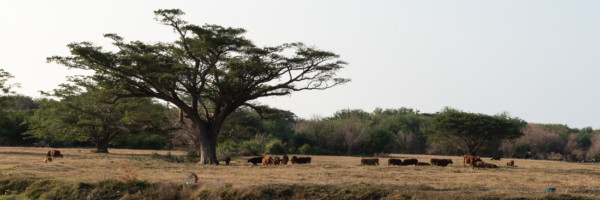
Years ago, this ranch had 10,000 head and now only 1,500. Ranches are smaller scale these days due to the hotter, dryer climate in Fiji.
Built in 1880, the Penang Sugar Mill in Rakiraki was the oldest mill in Fiji. A network of narrow-gauge railway lines fed the mill with cane from around this excellent cane-growing area. Unfortunately, the mill was badly damaged by Cyclone Winston in 2016. Costs to rebuild would have been too high, so it was abandoned. Now, sugar cane from the Rakiraki area has to be trucked to the sugar mill in Ba, some 70km away.
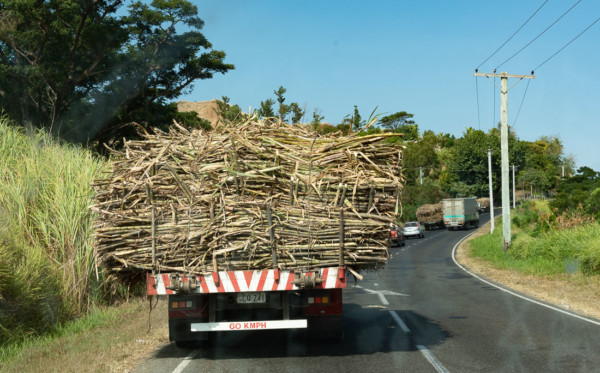
Cane truck strategically loaded with hand cut cane. Note the line of cane trucks, traffic and a truck attempting to pass up ahead.
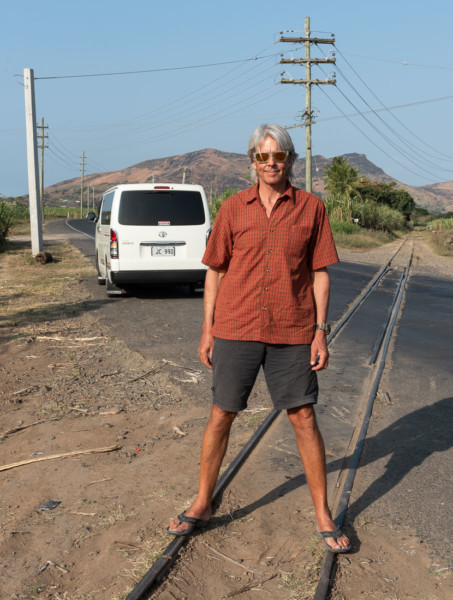
Monty on an abandoned narrow-gauge rail line, near Rakiraki. Our new taxi van behind.
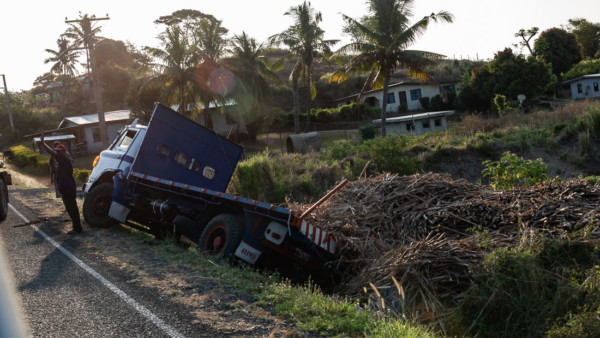
One cane truck that didn’t make it to the mill. Our driver said the truck had been sitting by the side of the road for 2 days as the brakes needed some work. Apparently they still need some work!
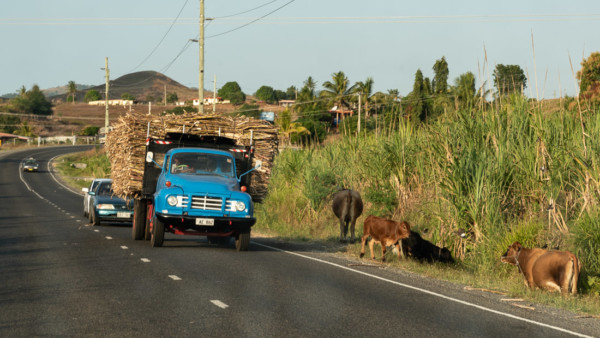
Along the roadside, it is common to see animals grazing on sugar cane that fell off the trucks. Bet that cane is tasty, and the meat too!
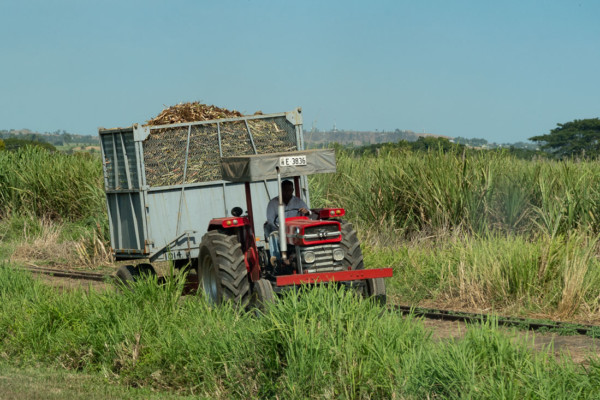
This tractor hauling a railcar filled with machine-cut cane to the siding. Notice it is cut up in small pieces. Technology is slowly arriving.
Ba Sugar Mill
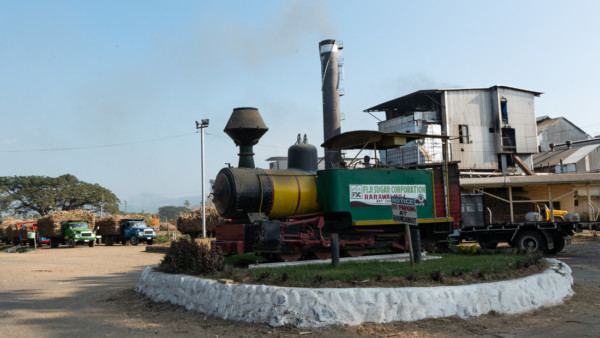
An old steam locomotive used on the cane train.

Cane trucks line up to unload. Some elaborately painted antique trucks. You could tell the owners took great pride in their trucks.
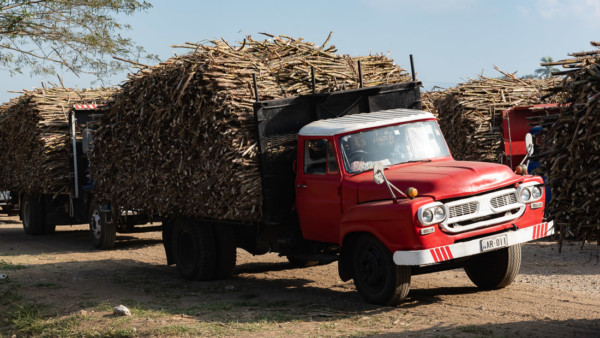
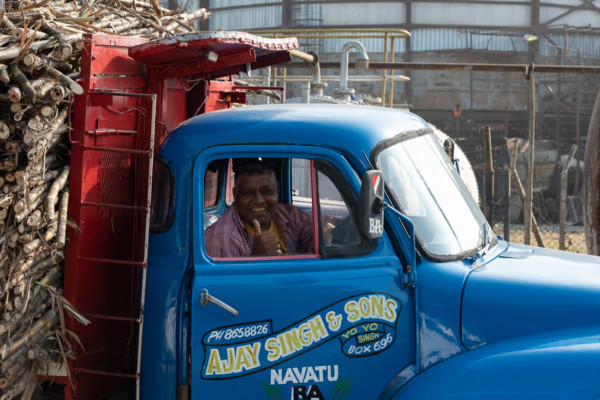
Smiles are free and Fijians love to use them, along with an audible “Bula”!
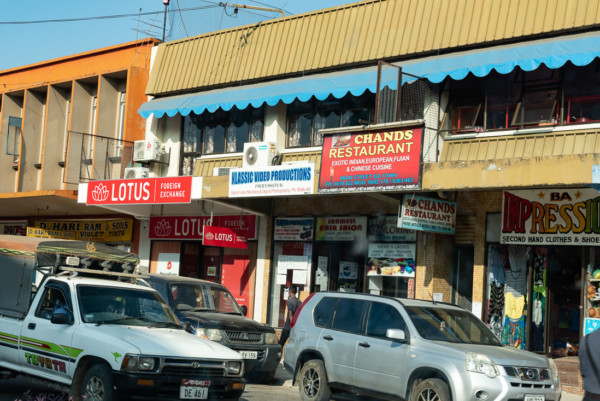
Downtown Ba
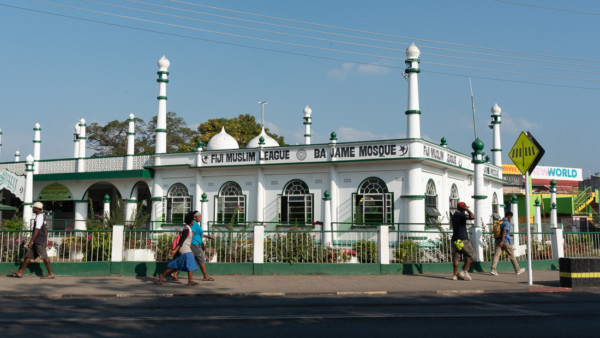
A Ba Town Mosque.
Every small community in the northern region of Viti Levu has a mosque but we noticed many brightly painted yellow and red shrines in the yards of many homes. Our driver explained that you can always tell a Hindu family by the shrines.
Indentured Indians were brought here by the British between 1879 and 1916 to work the plantations of cotton, copra and sugar cane as it was prohibited to employ Fijians. 80% of these worker were Hindus, 14% Muslims with Sikhs and Christians making up the balance. Today, 38% of Fiji’s population is Indo-Fijian with 80% being Hindu.
In 1919 the indenture formally ended and many stayed and brought their families. The cast system was abandoned as it was not practical. Many settled in the northern parts of Viti Levu and have farmed cane for generations. Avi said it is difficult for the families to keep farming now as the young people don’t want to farm, no doubt seeking an easier life. It is a common problem world-wide.
I asked Avi what language they spoke. In informal settings, the Info-Fijians speak Fiji-Hindi, a legitimate dialect, which is a blend of Hindi, Urdu (the language of Pakistan) with some English words. We hear it spoken around towns and in the markets where many vendors are Indo-Fijian. We are told that Indians can’t understand Fiji-Hindi. In school, they all learn Hindi or Urdu as well as English.
By contrast, native Fijians speak Fijian. There are around 300 varieties of Fijian, all related to the Austronesian family, the language of the first inhabitants. Two main groups of the language are widely recognized, Western Fijian and the Eastern Fijian, divided somewhat north-south through the mainland of Viti Levu.
If we stay in Fiji much longer, we will have to learn some sayings in both Fijian and Fiji-Hindi other than “Bula” (Hello) and “Vinaka” (Thank you).

Many cane trucks waiting to unload at the Lautoka Sugar Mill.
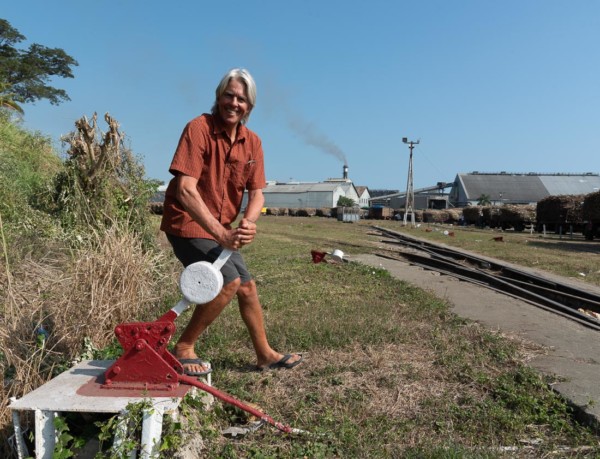
Monty setting up the switch for a derailment! This rail line was still in use.
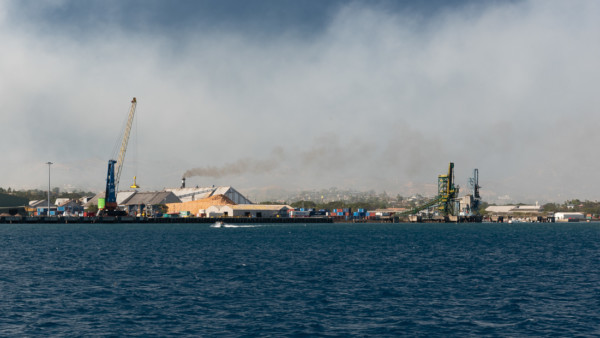
Lautoka Sugar Mill, as seen from our boat on another day. We later heard that the white smoke filling the sky behind the mill was from a fire at the garbage dump.
Our driver found the Immigration Office in short order. We filled out the forms and paid for our visa extension application fee ($90 FD/pp) and were told we would hear from them the following week. It took them almost three weeks to process the applications. Fiji Time!
We made a pit stop at McDonalds (for the cleanest restrooms worldwide). We then got on our shopping list, first dropping off our propane gas bottle to be refilled. Lautoka has one of the few refilling stations in Fiji. Most gas stations only offer to exchange gas bottles.
Next was the large produce market. Walking up and down the aisles, we found the usual items at the usual prices.
We visited Fiji Meats but didn’t buy much as the offerings were not that appealing. It may have been a bad time of day to visit.
The local wine-grocery shop carried a selection of imported goods which were added to our basket with delight. It is nice to find some foodie item you have been missing since you were home.
Next door was a casual Indian lunch spot. It was well passed lunch time, and we were starved. We asked Avi to join us for a quick lunch. We ordered boneless lamb curry, a big mistake! It took them almost an hour to serve our meals! They obviously struggled with the “boneless” request! We should have ordered one of the bone-in curries that were ready to go. Another lesson learned!
On our return trip, we stopped at a pull out for a beautiful vista of Nananu-I-Ra and the surrounding northern coastline of Viti Levu.

It was unsettling to see all the garbage left at the pull out, very typical in Fiji.
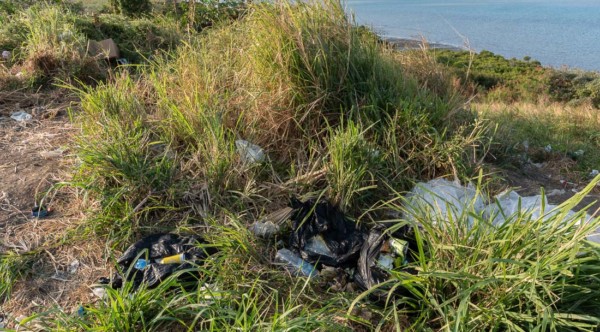
See that inspired us to clean up Kite Point. The island caretaker didn’t seem to think it was his job. Maybe he was disillusioned because garbage washes up everyday. Next time we went to Rakiraki, Monty dinghied to the point with a big bag and removed the pile of plastic and garbage that we picked up from the beach over the past couple months. We dropped it off at the dump on the way to town. It was small thing we could do for this beautiful kiting spot.
Avi asked us to come to his house for a coffee on the way back but it was close to sundown and our groceries needed to be refrigerated. We thanked him for his kind offer and asked for a rain-check. He was an excellent driver, pleasant, accommodating and informative too. We hope to take him up on his invitation another time.

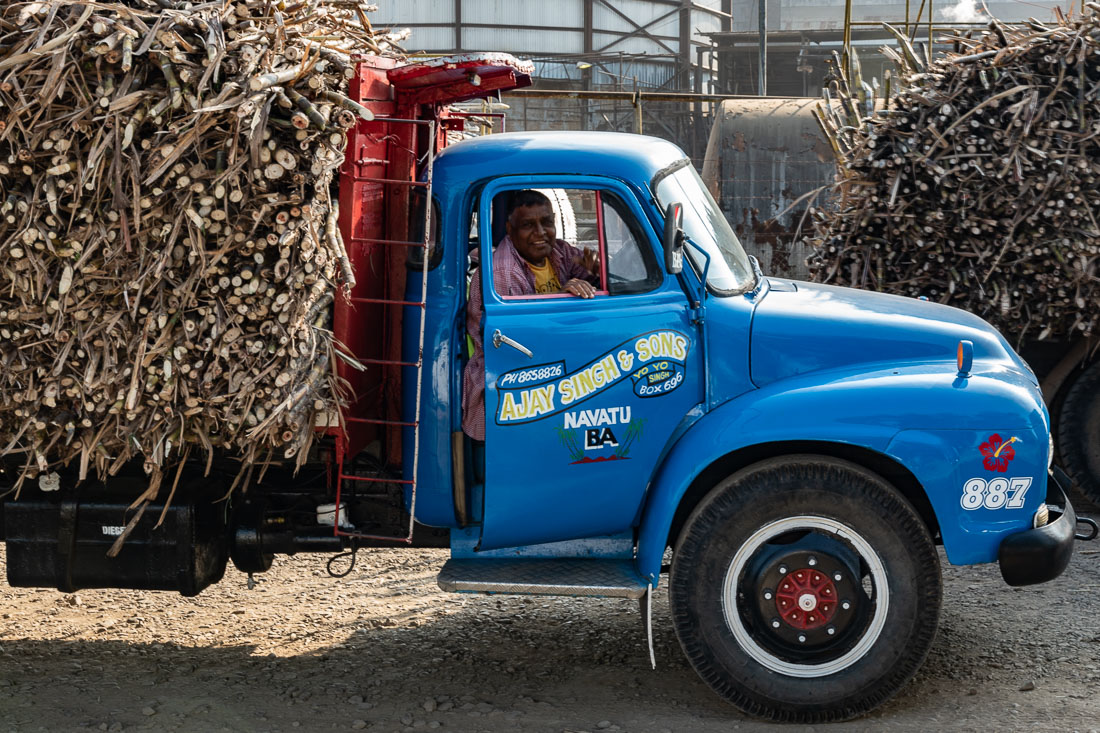
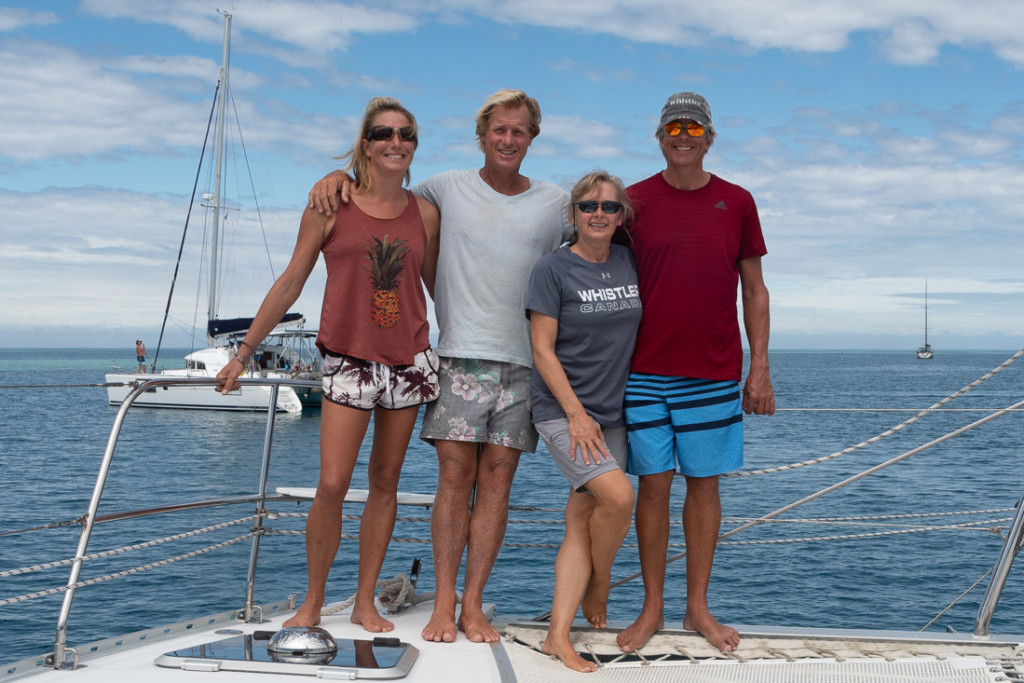

4 comments
A really interesting account of what could have been a mundane shopping trip. I enjoyed the mix of history ( the cannibal story, in particular) as well as the pictures and explanation of the current sugar cane industry. I really feel that I was along for the trip. Great writing and of course, as always, wonderful pictures. Good for you and Monty to pick up your garbage. We have noted so often on our trips that the local population is not concerned with litter destroying the beauty of their environoment. For an example of a pristine environment you need to go to the Azores. Not even a scrap of paper to be seen. Looking forward to your next episode.
Barb and Jim
Thanks for your comments. The garbage we picked up on the point was what had washed up on shore over the past few months. Be well! Love, Margy
What an interesting tour! Your thorough descriptions made me feel as though I was actually seeing the area
with you. Thank you for expanding my world.
I love reading these exciting stories and beautiful adventures. I hope Ii can join you for 1-2 weeks next year to” help with the sails””, just kidding i will be your sous chef!!!!
Sending lots of love ad safe travels
Renate